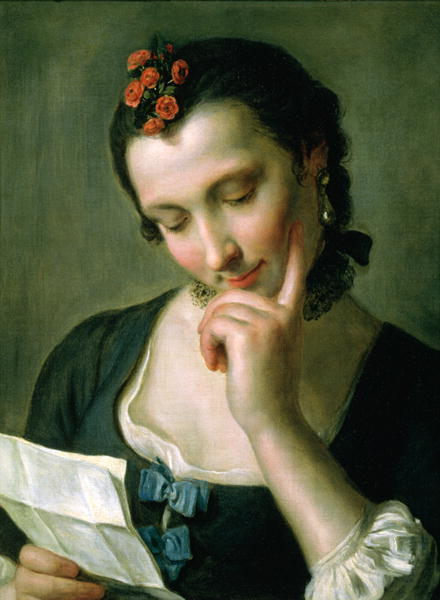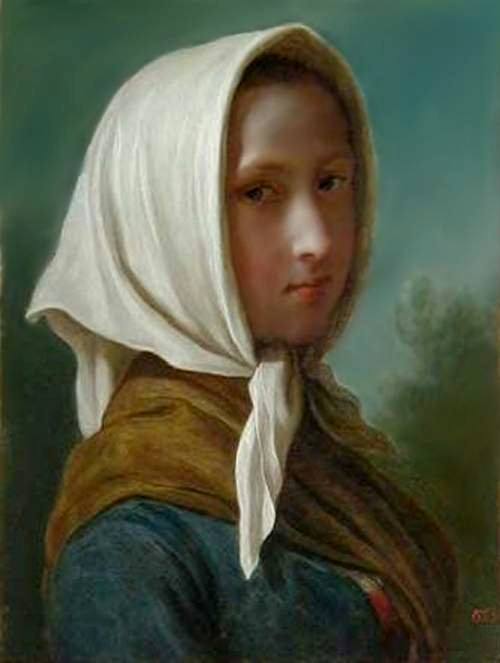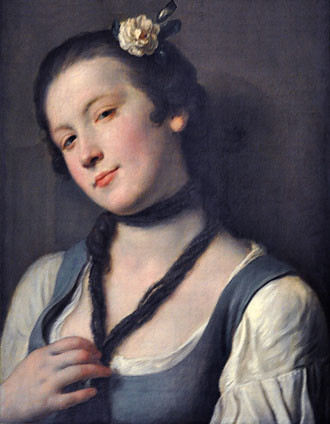This young woman's attitude reminds me of the doomed Lucy Westenra in Bram Stoker's novel, DRACULA.
Pietro Antonio Rotari (1707 - 1762) was an Italian painter born in Verona. As a young man he studied under Antonio Balestra in Rome and Francesco Trevisani in Naples. Thereafter he returned to Verona where he set up his studio and continued to paint in the Baroque tradition.
Later he moved on to Vienna and then to Dresden, Germany. He became court painter to Empress Elizabeth I, of Russia, but spent a great deal of time painting Russian villagers and peasants. Many of these painting were originally held in collections at the Russian Academy of Art and at Catherine II's Peterhof Palace.
I am very fond of Rotari's portraits of young women, usually reading or writing a letter or just staring out at the viewer, looking delicate yet full of rosy health.
Rotari has a good palette and I really like the way he draws heads. He has a light hand too with these young girls' features. Most especially I like their coquettish expressions. Once you've seen a Rotari portrait, you will, in general, always recognize his work if seen again. He has quite a specific point of view.
To learn a bit more about Rotari, please use this link.
Pietro Antonio Rotari - self portrait.



.jpg)














May I ask how you "discover" the painters/paintings you talk about on your blog? Or are you already familiar with them and just share them with the rest of us?
ReplyDeleteEither way, I certainly enjoy learning about them! Thanks!
Terri: You're welcome and thanks for dropping by.
ReplyDeleteMany of the artists I talk about are known to me from having lived a long life full of esoteric interests. :)
Many of them I 'discover' by serendipity - maybe a glance at one thing while I'm looking for something else.
There are many art resources on the web. I also have art books at home.
However I work it, it's always a lot of fun. I'm glad you're enjoying the result.
Hi, Yvette - Until your posting, I wasn't familiar with the work of Antonio Rotari, but I think you're quite right that I'll easily recognize any additional portraitsby him that I may encounter.
ReplyDeleteIt's always been a surprise to me that people who make their living as humorists can be curmudgeons in private, and I hope that there isn't a correlation to men who paint such lovely women. I'd like to think that Antonio was as charming as his sitters.
Very few artist's can paint that well today. He was wonderful. yvonne
ReplyDeleteOne would hope so, Mark. He looks a little dry (Maybe it's shyness.) in his self portrait, but maybe that's just his judgement of himself. It is so difficult to know with artists. They seem to pour themselves into their paintings and leave little behind for reality.
ReplyDeleteAlthough some manage both quite nicely.
Yvonne: I agree. This sort of painting doesn't exist anymore. The world has gone away from it.
ReplyDeleteHe did like fans, didn't he. Or maybe mouths were not his strong point.
ReplyDeletePossibly. :)
ReplyDeleteDo you know anything about his use of models? Nine of these paintings all look like the same woman - same eyebrows, same nose, same mouth. There is that left eyebrow (the model's, that is, so the one facing us on the right) the slopes downward to the bridge of the nose that is the most prominent giveaway.
ReplyDeleteI had the same immediate impression about the young ladies' charming coquettish expressions. I also enjoyed seeing the contrast between hair adornment or hiding the hair completely. I wonder if married women had to cover their heads?
ReplyDeleteI like the second down the best, the girl with the blue velvet cap. She looks like she's about to have some fun.
ReplyDeleteJohn, your picture looks like Meriwether Lewis to me.
Katie-
ReplyDeleteI stole my avatar from the cover of an edition of Dr. Nikola by Guy Boothby. He's the earliest master criminal character in Victorian literature. Though I'm really a dog man myself, I really love the illustration and had to accept his feline companion as part of the package. The character is one of my favorite bad guys in all of crime fiction.
John: I noticed that myself. It wouldn't be odd though, for a painter to work from a favorite model, so I attribute it to that.
ReplyDeletePat: You may be right. I think in those days of the 18th century, headwear often said many things. Even later into the 19th century, this remained true. In men, it had to do with status and profession, so it's possible the same thing applied to women - but in their case, having only to do with social class.
ReplyDeleteThis was an era when people wore sleeping caps!
Whenever I pay a visit to the Norton Simon Museum, I always enjoy looking at the last painting, Young Girl Writing a Love Letter. Her coquettish demeanor delights me.
ReplyDeleteThe Norton Simon actually has an impressive collection of Rotari's but, sadly, only this picture is regularly on display. The others languish in the vault.
If we could only have access to what museums keep in their back rooms! I guess they can't show EVERYTHING they have...but only ONE Rotari??
ReplyDeleteWell, I suppose it's better than nothing.